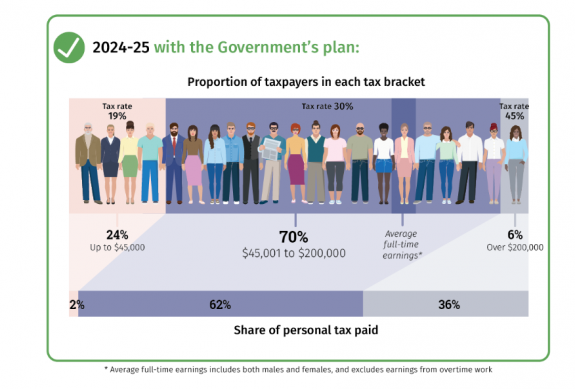Can the Federal LNP deliver its Flatter Taxation Scales in a Slowing Economy?

By Denis Bright
Just four months out from the federal election, current indicators do suggest that the federal LNP is fumbling the future of the investment sector of the Australian economy to achieve its short-medium term budget projections and to appease the erratic policies of the Trump Administration.
The IMF data on economic growth trends in Australia confirms the state of flux relating to federal budget projections and delivery of planned tax cuts for higher income earners. These trends will not be unscrambled until the release of the Mid-Year Economic and Fiscal Outlook (MYEFO) by early December 2019.
Finance Minister Mathias Cormann is still optimistic about future delivery of a fiscal balance for 2019-2020 without depressing economic growth projections or causing unemployment levels to rise further.
A key variable in this balancing act is the strength of the public sector spending at both state and federal levels as well as positive trend-lines for commodity and service exports. This favourable mix is marred by data for private sector capital investment over the last two quarters. Release of the September Quarter data on 28 November 2019 will be eagerly awaited. A continuation of the negative trends will be bad news for budget strategies for 2020-21, rather than in the current financial year.
Australia Private Capital Expenditure

To meet its budget targets, the federal LNP is now reigning in the growth in public sector. Probono Australia has revealed the benefits of under-spending on National Disability Insurance (NDIS) to the federal LNP’s efforts to maintain current budget surplus projections for 2019-20 (Luke Michael, ‘NDIS underspend helps return budget to the brink of surplus’, 20 September 2019):
The federal government spent $4.6 billion less on the National Disability Insurance Scheme than expected because of delays getting people into the program, new budget figures reveal.
Treasurer Josh Frydenberg on Thursday announced the final budget outcome for 2018-19, showing a deficit of $690 million – $13.8 billion less than what the 2018 budget predicted.
This improved financial position – which leaves the budget on the brink of surplus for the first time since 2007-08 – was built on the back of underspending in areas including the NDIS.
The government says this underspend is a result of a slower than expected transition of people into the NDIS, but critics argue the money should be spent fixing various problems plaguing the scheme.
Frydenberg said the NDIS was a “demand driven system”, meaning that a slower uptake of the scheme resulted in less money being spent.
“This is in part because of the delays in some of the states coming on board, and also because it’s taken a bit more time for the service provider market to develop sufficiently to meet the available demand,” Frydenberg said.
Caution with the delivery of future Newstart increases and the delivery of NDIS will assist in the extension of taxation relief that is skewed to middle- and upper-income households as promised in the 2019-2020 federal budget.

Support for market-oriented strategies of the federal LNP came from the US Secretary of Commerce Wilbur Ross on his Australian visit with one important policy recommendation (The Australian, Geoff Chambers, ‘Tax cuts key to driving revival, says Wilbur Ross’, 10 October 2019):
US Secretary of Commerce Wilbur Ross has suggested Australia could increase its global competitiveness and attract direct foreign investment if it replicated Donald Trump’s corporate tax cuts.
Speaking to The Australian on Wednesday, Mr Ross — one of Mr Trump’s closest advisers — said the US company tax cuts combined with regulatory reform had worked “very, very well”.
Wilbur Ross should have added a note of caution to his Aussie Allies Down Under as shown by the latest data from his own Bureau of Economic Analysis (BEA) in his own US Department of Commerce as released on 24 July 2019:
Direct Investment by Country and Industry, 2018
The U.S. direct investment abroad position, or cumulative level of investment, decreased $62.3 billion to $5.95 trillion at the end of 2018 from $6.01 trillion at the end of 2017, according to statistics released by the Bureau of Economic Analysis (BEA). The decrease was due to the repatriation of accumulated prior earnings by U.S. multinationals from their foreign affiliates, largely in response to the 2017 Tax Cuts and Jobs Act. The decrease reflected a $75.8 billion decrease in the position in Latin America and Other Western Hemisphere locations, primarily in Bermuda. By industry, holding company affiliates owned by U.S. manufacturers accounted for most of the decrease.
The foreign direct investment in the United States position increased $319.1 billion to $4.34 trillion at the end of 2018 from $4.03 trillion at the end of 2017. The increase mainly reflected a $226.1 billion increase in the position from Europe, primarily the Netherlands and Ireland. By industry, affiliates in manufacturing, retail trade, and real estate accounted for the largest increases.
US Investment plays a relatively minor role in the Asia Pacific Region compared with commercial interactions with Britain and Europe as well as countries in the American Hemisphere from Canada to Central and South America:

Making America Great Strategies have resulted in a decline in US Capital Flows across the Asia Pacific Region between 2017 and 2018. Australia is an exception to the regional trends and provides the US with highly favourable surpluses for trade in commodities and services as well as capital flows.
Days after this visit to Australia by Wilbur Ross, President Trump announced new compromises in his trade and investment war with China that undercut our own export gains in the Asia Pacific Region in favour of new export incentives from the US farm lobby.
The honeymoon after the last election may still be in session. As the rhetorical euphoria continues, it is time for Aussies to do a fact check of our unfavourable commercial relations with the USA. The Trump Administration has left Australians high and dry in a slowing global economy as the Trade and Investment War is replaced by a new Lovefest with China to the cheers from the US farm and resource sector lobbies which are our real competitors on the world market.
It’s surely time for our federal LNP leaders to show a spark of independence in defending Australia’s commercial sovereignty within the Australia-US Free Trade Agreement as President Trump focuses on his re-election strategies for November 2020.
 Denis Bright (pictured) is a member of the Media, Entertainment and Arts Alliance (MEAA). Denis is committed to citizens’ journalism from a critical, structuralist perspective. Comments from Insiders with a specialist knowledge of the topics covered are particularly welcome.
Denis Bright (pictured) is a member of the Media, Entertainment and Arts Alliance (MEAA). Denis is committed to citizens’ journalism from a critical, structuralist perspective. Comments from Insiders with a specialist knowledge of the topics covered are particularly welcome.
Like what we do at The AIMN?
You’ll like it even more knowing that your donation will help us to keep up the good fight.
Chuck in a few bucks and see just how far it goes!









